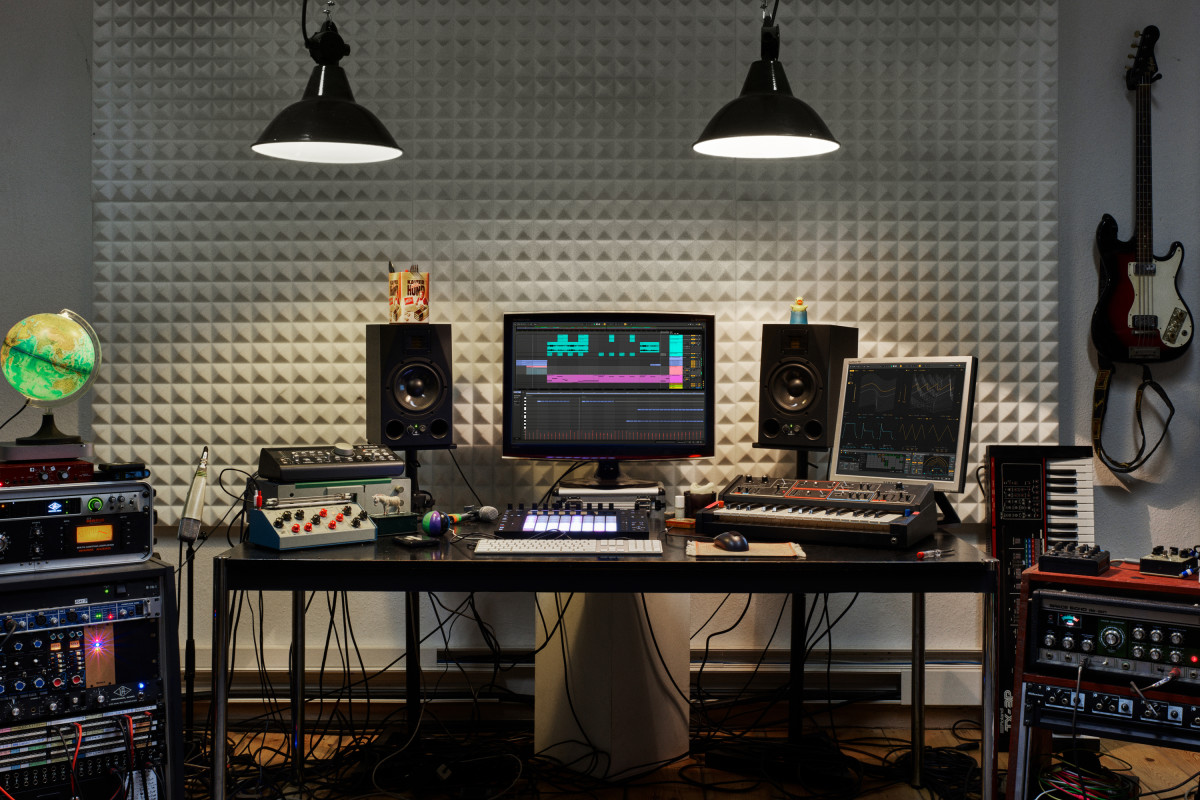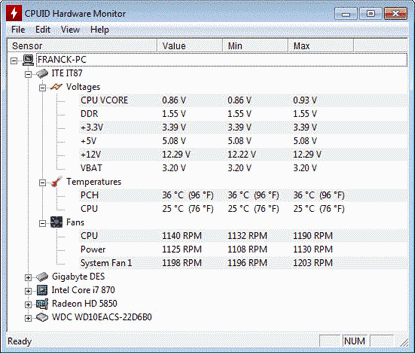- The Open Hardware Monitor is a free open source hardware monitoring tool that monitors temperature sensors, fan speeds, voltages, load and clock speeds of a computer. It also monitors CPU temperature by reading the core temperature sensors of Intel and AMD processors.
- A hardware monitoring software that will read the system's main health sensors. HWMonitor is a hardware monitoring application that reads PC systems main health sensors: temperatures, voltages.
Do you thrive on information—lots of information? Have you ever tried to diagnose an odd system problem, thinking it might be heat- or power-related, and wished you knew more about what was going on inside your Mac? Do you like attractive graphs with lots of data points that might even be useful at some point in time? If you answered yes to these questions, then you’re an ideal candidate for Marcel Bresink Software-Systeme’s Hardware Monitor (; €7.00 per machine).
The benefit of HWiNFO is that it also displays real-time information about the hardware which is highly useful for monitoring hardware for health issues. PC Wizard The information provided by PC Wizard is especially useful for finding new devices installed in the computer but they can’t be identified and their drivers are unknown. SIV by Ray Hinchliffe. 'System Information Viewer' is a general Windows utility for displaying lots of useful Windows, Network and hardware info - CPU info, PCI info, PCMCIA info, USB info SMBus info, SPD info, ACPI methods, Machine info, Hardware Sensors, Networked computers, Operating System Information and more.

Hardware Monitor is a utility that reads and reports on the various sensors in your Mac. Sensors? Yes, sensors. You may not have known it, but your Mac is chock full of sensors. Exactly how many, and what they sense, depends on which Mac you own: On my aging 12-inch PowerBook G4, Hardware Monitor found 10 sensors. On my Mac mini (1.66GHz Core Duo), there are a total of 13 sensors available. On my MacBook Pro, however, there are 29. This seems like quite a lot, until you compare it with a desktop tower—Hardware Monitor on my Mac Pro lists a total of 55 separate sensors.
So what, exactly, do these sensors sense? Depending on your particular machine, you can monitor things such as ambient temperature; volts, amps, and watts for CPU, bridge chips (e.g. northbridge) and power supply; various fan speeds; and temperatures for hard drives (on SMART-compatible drives, at least), hard drive bays, CPU cores and heatsinks, memory chips and memory banks, the power supply, and expansion slots. In short, just about anything you want to monitor can be monitored—assuming your machine has the right sensors.
Hardware Monitor Reddit
How do you know what sensors your machine has? Hardware Monitor will tell you—and use that information as an incentive for you to register the program. In demo mode, Hardware Monitor displays temperature-sensor data only. Another window appears listing the additional sensors you’ll be able to see after you register, as seen here on my Mac mini:
On the mini, I can see eight different temperature sensors in demo mode. If I were to register the program on the mini, I’d gain access to the voltage, current, and power sensors on the CPU, as well as the RPM of the fan and the actual clock frequency of the CPU. If your machine doesn’t have many/any additional sensors—or if those that exist aren’t of any value to you—then you can use Marcel’s freeware Temperature Monitor to just keep an eye on the temperature readouts. For something like my mini, this might make sense, as there’s not much in the way of additional sensor data available.
Displaying sensor data
With so much data at hand, one of the challenges is managing it all—you’ll probably never want or need to keep a constant eye on everything. Thankfully, Hardware Monitor excels at presenting sensor data exactly as you might wish to see it. You can view sensor output in a multitude of places—in a window, directly on (or floating above) your Desktop, in the Dock, in the menu bar, and even in a Dashboard Widget. Each of these display options can contain any or all of the available sensors. So you could, for instance, keep the CPU temperature in the menu-bar icon, the hard drive temperature in the Dock, and the fan speeds and CPU temperatures directly on your Desktop. Each sensor’s output can be customized to your liking—name, color, etc. Here are CPU temperatures and graphics load shown on the Desktop:
While these instantaneous display of sensor readings is interesting, Hardware Monitor’s charts of historical readings—which display the output from any number of similar-data (temperature, fan speed, etc.) sensors—are more useful for analyzing your machine over time. Included are a number of pre-defined history windows that display readings over time for temperature, frequency, power, load, voltage, fan speed, and more, or you can easily create your own. Each window can display both short-term readings (the most-recent 380 observations) and long-term readings (up to one week’s worth, once per minute). Here are a couple charts showing my Mac Pro’s CPU temps and graphics-processor load over a roughly ten minute period:
Probes
If the available hardware sensors don’t meet your needs, Hardware Monitor can also create probes. A probe can be thought of as a software sensor—instead of a physical hardware device, a probe reads values that OS X knows, and can then use those values as if they came from a sensor. There are close to 30 probes in total, including probes to watch hard drive space, CPU load, various network activities, SMART drive status, battery capacity, virtual memory page outs, and more.
Adding a probe is simple: on the Probes tab of Hardware Monitor’s preferences, you select which type of probe you’d like to add, then click on the plus sign. Once created, probes also show up on the Sensors tab, giving you control of the same settings (name, color, etc.) and viewing options that you get for hardware sensors.
Alerts

Hardware Monitor App
While monitoring all these sensors and probes can be interesting, it’s really not the best way to use Hardware Monitor—after all, what are the chances you’ll be looking at the screen at the exact moment something happens that you’d like to know about? That’s where Alerts come in. Hardware Monitor has two ways of alerting you to changes in sensors and probes, accessible via the Speech and Alert tabs in the program’s preferences. (Confusingly, you can use speech within Alerts.)
Remote monitoring
Finally, Hardware Monitor can do everything I’ve just described for remote Macs, as well. You install the developer’s Hardware Monitor Remote software on a remote Mac and then connect to that Mac from within Hardware Monitor on your Mac. The remote Mac’s sensors are available anywhere your local sensors can be used—alerts, custom history graphs, etc. (In sensor listings, a Computer column tells you which sensor is attached to which Mac.) If you’re running a lab full of Macs and want to keep an eye on their operating conditions, the remote-monitoring feature in Hardware Monitor seems to provide a perfect solution.
Useful information—and lots of it


Hardware Monitor isn’t for everyone, and the sheer volume of things it tracks means that setting it up precisely for your needs can take some time. But if you can see past the scale of the program, it offers some really useful features—even if nothing’s going wrong with your Mac. I find the alerts particularly useful, as they let me know when I’ve done something dumb; for example, when I accidentally copied a FireWire drive to the wrong internal drive, the free space alert popped up, letting me know something was filling my drive.
Hardware Monitor Mac

Hardware Monitor is free to try (for the temperature monitors, at any rate) and relatively inexpensive to purchase. It’s well worth the download time, and if you’re an “infoholic,” as I am, you may find it to be indispensable.
